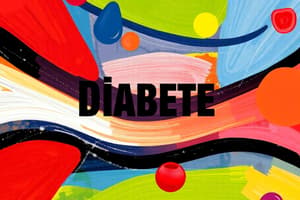Podcast
Questions and Answers
ما هي السمة المميزة لمجموعة اضطرابات السكري؟
ما هي السمة المميزة لمجموعة اضطرابات السكري؟
- ارتفاع مستويات السكر في الدم لفترة طويلة (correct)
- نقص استهلاك الأنسولين في الجسم
- نقص إنتاج الأنسولين في الجسم
- استهلاك زائد للغلوكوز في الجسم
ما هو الاسم الآخر الذي يُطلق على السكري من النوع 1؟
ما هو الاسم الآخر الذي يُطلق على السكري من النوع 1؟
- السكري الشبابي (correct)
- السكري المُعتمد على الأنزولين
- السكري يعتمد على الأنسولين
- السكري المستعبدي للأنسولين
ما هي نتيجة تدمير الخلايا بيتا التي تنتج الأنسولين في البنكرياس؟
ما هي نتيجة تدمير الخلايا بيتا التي تنتج الأنسولين في البنكرياس؟
- زيادة مستوى السكر في الدم (correct)
- انخفاض مستوى الأنسولين في البلازما
- زيادة مستوى الأنسولين في الدم
- انخفاض مستوى السكر في الدم
ما هي المشكلة التي يُعاني منها مرضى السكري من نوع 2؟
ما هي المشكلة التي يُعاني منها مرضى السكري من نوع 2؟
ما هي أحد المؤشرات التي تزيد من خطر الإصابة بالسكري من نوع 2؟
ما هي أحد المؤشرات التي تزيد من خطر الإصابة بالسكري من نوع 2؟
ما هو التأثير المحتمل للإصابة بالسكري إذا ترك دون رعاية وإدارة كافية؟
ما هو التأثير المحتمل للإصابة بالسكري إذا ترك دون رعاية وإدارة كافية؟
Flashcards are hidden until you start studying
Study Notes
Diabetes is a group of metabolic disorders characterized by high blood sugar levels over a prolonged period. It primarily involves problems with insulin secretion or utilization, which affects glucose regulation within the body. There are two main types of diabetes: type 1 diabetes and type 2 diabetes.
Type 1 Diabetes
Type 1 diabetes, also known as juvenile diabetes or insulin-dependent diabetes, is an autoimmune condition where the immune system attacks and destroys insulin-producing beta cells in the pancreas. This results in little or no insulin being produced, leading to elevated blood sugar levels. As it cannot be cured, treatment focuses on managing blood sugar through regular insulin shots or insulin pump therapy.
Type 2 Diabetes
Type 2 diabetes is more common, accounting for approximately 90% of all diabetes cases. It occurs when the body becomes resistant to insulin or when the pancreas can't produce enough insulin. This leads to higher blood sugar levels. Risk factors for type 2 diabetes include obesity, lack of physical activity, genetics, age, certain ethnicities, and other health conditions. Treatment typically includes lifestyle changes such as diet and exercise, oral medications, and sometimes injectable medications.
Both type 1 and type 2 diabetes can lead to serious complications if left unmanaged, including heart disease, stroke, kidney damage, vision loss, nerve damage, and foot problems. Regular monitoring of blood sugar levels is crucial for managing these conditions. Early diagnosis and proper management significantly reduce the risk of complications.
Studying That Suits You
Use AI to generate personalized quizzes and flashcards to suit your learning preferences.



